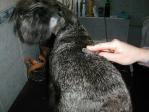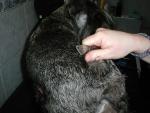HAIR CARE
Initial hair adjustment or starting from the puppy
So you have brought home a small fluffy ball which hardly resembles a well-taken-care-of Schnauzer. A bristly-haired puppy might look lovely, but you have to bear in mind the hair care in the first months of its life. Some breeders sell their puppies with adjusted hair – they cut their cheek, ear and neck hair, back parts and cut the paw hair into the shape of a ball so that no hair is sticking out. This hair adjustment is very important as cheek hair can bring about rising of the ears. Neatly cut hair is crucial for hygiene and when the paws are nicely cut, less dirt sticks to it. First of all, the puppy needs to get used to the fact that it will be manipulated with, which won’t be possible without a certain level of violence in the initial stage. When adjusting the hair of an 8-month-old puppy, we cannot expect it to stand still. Take it to a place it doesn’t knot yet (e.g. to another room, to an adjusting table, etc.), we talk to it calmly and if it manager to stand still for a while, we give it a treat. Then take a small brush a try to brush the puppy very carefully while calming it down so that it understands that nothing bad is going on. As soon as it lets you brush it a little, praise it and give it a treat and take it back among other puppies. Repeat this process several times with other puppies as well. The following day there shouldn’t be any problems brushing the puppies and we can getting the puppy used to scissors or a trimmer. Turn the trimmer on, click the scissors but don’t touch the puppy yet. Don’t forget to praise the puppy and give it a treat. When it doesn’t react to the scissors or the trimmer, try to cut its hair. We suggest you have some helping hand around who can hold it and turn its attention to something else. Make sure the helping hand doesn’t act as a „saviour“ who takes the puppy off the adjustment table saying that it suffers. You must be the one who says when it ends and who lets the puppy down to the ground praising and treating it.
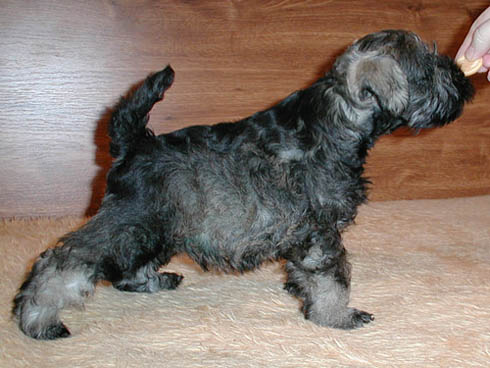
This is what a 2-month-old puppy looks like without any hair adjustment.
If the puppy you’ve bought isn’t cut or you are a breeder follow these instructions:
When the puppy is about 8 months old, cut it with a trimmer or scissors. Cut the cheeks, ears and neck.
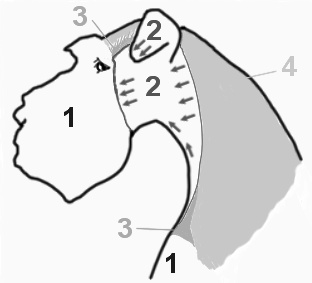
- Don‘t cut this hair yet – moustache, eyebrows and fore chest.
- Hair to be cut to 2-3 mm. Cut in the direction of the arrows, against the hair on the cheeks and the neck , with the hair on the ears. Cut the ear tips with a round scissors so that no hair is sticking out. Cut the bottom part of the ears around the auricle. Tear out the hair inside the ear with fingers so that the inner ear is clean and airy.
- The transitions between short/cut hair and longer hair should be smooth. Especially with puppies, this is difficult to achieve as they usually fight and don’t cooperate. However, this can be done using specialized affiliation scissors.
- Hair which should be firm and of quality colour. Do not cut this hair, just comb it . When a puppy is about 3 months old we can start combing it with a trimming knife with the hair and regularly remove the underfur.
Here are some pictures of a puppy of 6 weeks to 3 months old which can help you see how to cut the hair, what the transitions should look like, etc.
When the puppy is about 8 weeks old, cut the inner parts of the tights,
around the genitals and the anal orifice.
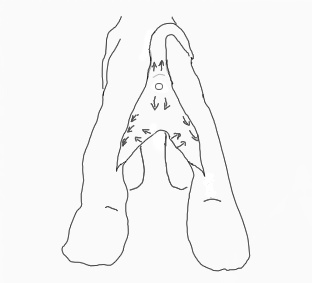
The picture shows the directions which the hair should be cut. As the hair around the anal orifice grows in two directions, we have to change the direction of the cutting according to the hair growth direction. Always cut against the hair. Cut the bottom tail hair about 1-2 cm over the back level and affiliate the transition.
Be very careful when cutting the hair very close to the genitals and anal orifice using scissors with a round tip. Have somebody hold the puppy for you.
Some pictures of puppies
Cut the paws into the shape of a „mouse paw“ in the directions shown
in the pictures using round tip scissors.
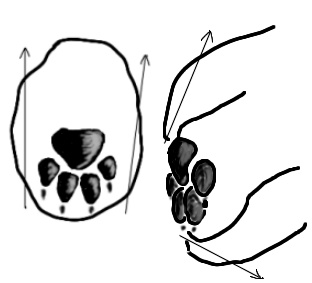
See the picture for direction of cutting long paw and the length of the hair. Cut the bottom part hair so that it is round.
Also check the length of the claws. If they are too long and hooked, cut them using special scissors. Make sure you don’t cut too much of the claws so as not to hurt the puppy.
Follow these instructions until the puppy is 4 to 6 months old and the hair is ready for trimming. To check if the hair is ready for trimming hold several pieces of hair in between your fingers and softly pull. It should be easy to pull the hair out and the puppy should show hardly any reaction. Then it’s time to move on to next stage – first trimming. Comb the hair to be trimmed with a trimming knife and the rest of the hair with a brush. Trim the hair against the hair growth to remove the underfur. This makes trimming much easier. Trim comb the underfur approximately once a week depending of how much there is. Do not wash the puppy if possible. If needed wash the paws with warm water and put off first washing until the first overall hair adjustment.
First trimming
Start trimming the puppy when its cover hair is ready for it which is at
about the age of 4 to 6 months. Then you can carry out the complete hair
adjustment of a Schnauzer. Make sure not to wash the puppy before the
total trimming. It’s better to trim greasy hair but the hair you are
going to cut has to be clean and combed out. Therefore, it’s better to
trim the puppy first, then wash it and cut and adjust the hair after that.
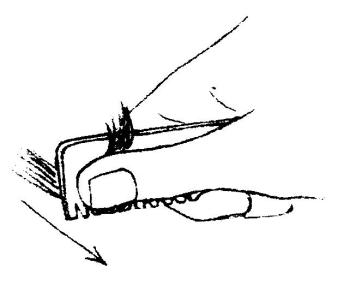
Trimming is pulling out mature cover hair using a trimming knife (see the picture above). When the hair is mature enough, trimming is very easy and painless. Trim the hair up to the underfur. Pull out all the hard cover hair and cut the rest of the underfur, either black, black-silver or white using a machine. Be very careful with salt-and-pepper colour. Trim the head hair first and continue downwards to the back and sides and the outer parts of tights. The hair on the chest and edges of the inner tights remains long after trimming. Cut the hair on throat, cheeks, ears, bottom part of tail, anal orifice, inner parts of tights and genitals, even if the Schnauzer is of salt-and-pepper variety. Use a machine with a 3-mm head to cut the hair against its growth. Cut the edges of ears to the tip with regular scissors. Cut the hair on the sides of the head up to the level of the connecting line of the outer corner of the eye and the corner of the mouth. Make sure not to cut the hair underneath the eyes. This would make the cheeks too distinctive and the head wouldn’t look graceful enough. Do not trim the top of the head either. Cut the eyebrows from the inner corner of the eye aslant forward.
Basic equipment you need is two trimming knives:

- A trimming knife (the blue one)
- A knife more cutting teeth for brushing the loose underfur (the red one)
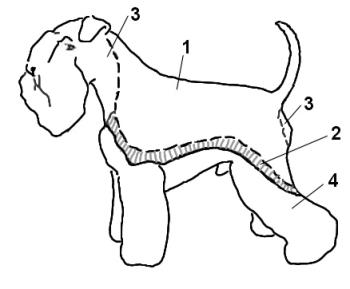
The complete hair adjustment of a Schnauzer:
- The parts of the body that need to be trimmed including the top of the head. You can cut the underfur in this part after trimming. Do not cut the underfur of the salt-and-pepper colour puppies (see chapter Hair adjustment of the salt-and-pepper variety). Trim the upper part of the tail the same way as the back. The hair on the lower part should transit smoothly from the anal orifice to the cover hair. Cut the hair approximately 2 cm above the anal orifice and affiliate so that the transition is as smooth as possible. Trim or affiliate the tail hair more often as it is usually the hardest hair on the body. The tail should naturally complete the nice look of a dog and there should by no hair sticking out.
- The transitions between the trimmed hair (hard) and soft hair that is only cut. Finely trim and comb the underfur to create a nice transition using affiliation scissors.
- The cut parts – the 3-mm head of the machine. See chapter Getting ready for an exhibition for detailed instructions.
- The parts that are only cut into a shape can be leveled at the first trimming but don’t necessarily have to. See chapter Getting ready for an exhibition for detailed instructions.










